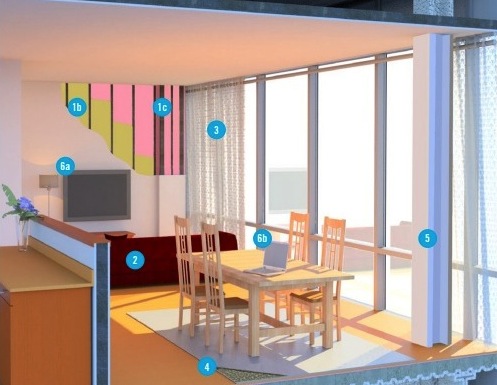Global architecture and design firm Perkins+Will has released new research in response to the need for architects and interior designers to develop a better understanding of flame retardants and their impact on health.
The white paper, “Healthy Environments: Strategies for Avoiding Flame Retardants in the Built Environment,” was developed by Perkins+Will’s Healthy Materials Group and Science Fellow Michel Dedeo. It identifies both new and existing opportunities to design healthier buildings without compromising fire safety or code compliance.
Flame retardants in the built environment are associated with a range of health impacts including cancer, endocrine disruption, and neurodevelopmental problems. Many flame retardants are persistent, bioaccumulative, and/or toxic, and their use in buildings is largely avoidable.
Perkins+Will’s white paper includes a list of 193 flame retardants, including 29 discovered in building and household products, 50 discovered in the indoor environment, and 33 discovered in human blood, milk, and tissues.
The research can help designers identify which products should be subjected to extra scrutiny during the design and construction process and provides options for less hazardous alternatives. The white paper also helps to identify gaps in current understanding of the sources and paths of chemical exposure.
“We want to bring awareness to this important issue impacting the health and wellbeing of building occupants,” said Perkins+Will’s Healthy Materials Leader Suzanne Drake. “The research we have conducted is a valuable resource for identifying healthy alternatives to flame retardant building materials.”
Related Stories
| Jul 18, 2014
Engineering firms look to bolster growth through new services, technology [2014 Giants 300 Report]
Following solid revenue growth in 2013, the majority of U.S.-based engineering and engineering/architecture firms expect more of the same this year, according to BD+C’s 2014 Giants 300 report.
| Jul 18, 2014
Top Engineering/Architecture Firms [2014 Giants 300 Report]
Jacobs, AECOM, Parsons Brinckerhoff top Building Design+Construction's 2014 ranking of the largest engineering/architecture firms in the United States.
| Jul 18, 2014
Top Engineering Firms [2014 Giants 300 Report]
Fluor, Arup, Day & Zimmermann top Building Design+Construction's 2014 ranking of the largest engineering firms in the United States.
| Jul 18, 2014
Top Architecture Firms [2014 Giants 300 Report]
Gensler, Perkins+Will, NBBJ top Building Design+Construction's 2014 ranking of the largest architecture firms in the United States.
| Jul 18, 2014
2014 Giants 300 Report
Building Design+Construction magazine's annual ranking the nation's largest architecture, engineering, and construction firms in the U.S.
| Jul 7, 2014
7 emerging design trends in brick buildings
From wild architectural shapes to unique color blends and pattern arrangements, these projects demonstrate the design possibilities of brick.
| Jul 2, 2014
Emerging trends in commercial flooring
Rectangular tiles, digital graphic applications, the resurgence of terrazzo, and product transparency headline today’s commercial flooring trends.
| Jun 30, 2014
Arup's vision of the future of rail: driverless trains, maintenance drones, and automatic freight delivery
In its Future of Rail 2050 report, Arup reveals a vision of the future of rail travel in light of trends such as urban population growth, climate change, and emerging technologies.
| Jun 18, 2014
Arup uses 3D printing to fabricate one-of-a-kind structural steel components
The firm's research shows that 3D printing has the potential to reduce costs, cut waste, and slash the carbon footprint of the construction sector.
| Jun 12, 2014
Austrian university develops 'inflatable' concrete dome method
Constructing a concrete dome is a costly process, but this may change soon. A team from the Vienna University of Technology has developed a method that allows concrete domes to form with the use of air and steel cables instead of expensive, timber supporting structures.

















